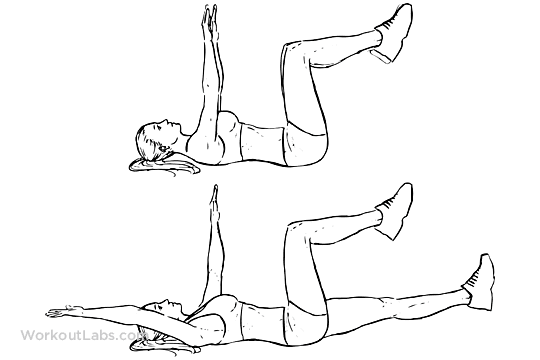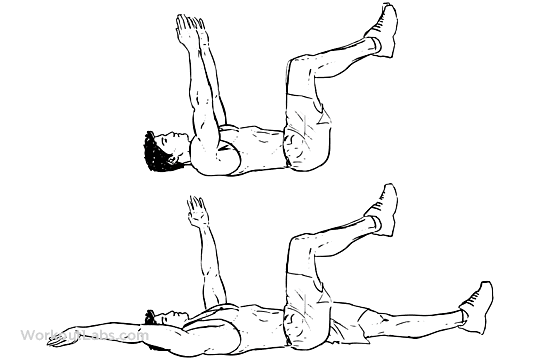The “dead bug” is an isometry exercise for the abdominal muscles that aims to train the anti-extensor and anti-rotational component of the abdominal muscles. In this exercise the core must contribute to the movement of the limbs by creating a stable base in the pelvis and rib cage.
In the shoulder flexion movements in favor of gravity the rib cage tends to rotate bringing the lower portion upwards. This is accompanied by an extension of the lumbar spine.
This often occurs due to a lack of mobility in the thoracic spine. In a physiological shoulder flexion, the last degrees of movement are borne by the scapula-thoracic joint, in particular a lateral rotation of the scapula is accompanied by an extension of the thoracic spine.
In unilateral hip flexion movements, the pelvis tends to flex from the side of the moving leg, while if the hip is extended unilaterally, the hemibacin ipsilateral to this limb tends to go anti-version.
The pelvis rotates forward (anti? Version) due to a relative weakness of the abdominal muscles with respect to the hip flexors: these try to eccentrically control the (relatively high) weight of the limb and therefore contract and thus "leverage" on the their proximal insertion and therefore "pulling" the pelvis forward.
All these dynamics are strongly reflected in daily movements and reinforcing a neutral position of the lumbar spine allows you to avoid unwanted compression stress.
Furthermore, the strengthening of these muscles allows you to carry out many other movements having greater stability in the abdominal region and less stress on the spine in general.
How to do it
The dead bug works as follows:
- Starting in a supine position, i.e. back to the ground.
- Focus on the lower back and imagine flattening this region against the ground trying to constantly maintain contact between these two surfaces.
- Bring both hips into flexion while keeping the knees flexed at 90 degrees.
- Flex both shoulders so that your arms are perpendicular to the ground.
- From this starting position bring one arm back, then increase the flexion.
- Simultaneously bring towards the ground, then extend, the lower limb against lateral.
- Try to achieve maximum shoulder flexion and maximum hip extension without touching your hand or foot. The elbows and knees must remain extended.
- Maintain the position of maximum tension for a couple of seconds and then return to the starting position and repeat with the two opposite limbs. This is a repeat.
- In order for the exercise to be carried out correctly, the lumbar area must remain in constant contact with the ground.

Muscles involved
This movement exploits a cross kinetic chain that can be assimilated to that of the walk.
In fact, when walking, the weight of the trunk is transferred according to cross kinetic chains from one side of the trunk to the opposite lower limb.
This exercise, in some respects, goes precisely to train the stability of this kinetic chain. The muscles involved are all four muscles that make up the abdominal wall.
- Rectus abdominis: this has an anti-extensor function and therefore keeps the lumbar area in constant contact with the ground.
- External oblique: this has an anti-rotational function and therefore allows the trunk to remain in position when the lower counter-lateral limb extends. This function is also performed by the external counter-lateral oblique to the upper limb in flexion.
- Internal oblique: this contributes to the stability of the pelvis during the entire flexion-extension movement of the lower limb. It also helps to keep the pelvis back towards and the rib cage lowered.
- Transverse abdominal: this muscle is the deepest of all and as such must be able to create a stable base of support. This muscle therefore acts as a general stabilizer of the abdominal region as well as maintains the lower back in neutral alignment
Common mistakes
The errors that occur can be traced back to an incorrect application of the technique or to muscle weakness. For example, if it is not possible to keep the lumbar region constantly in contact with the ground, it means that the abdominal muscles are too weak in relation to the excursion of the lower limb.
It could also be reduced mobility in the thoracic region which is compensated for by lumbar extension. in both cases the solution is the same, that is to limit the excursion of the limbs in order to reduce the load or reduce the demands for mobility.
Another mistake is not breathing properly. The breaths during this exercise must be deep and complete in order to stimulate abdominal breathing and take advantage of all the actions of the abdominal muscles.
In particular it is good:
- Breathe out in the phase of maximum tension. The exhalation should end with the two seconds of maximum contraction, remain in apnea while returning to the starting position. Breathing must be abdominal.
- Inhale before performing each half rep.




























